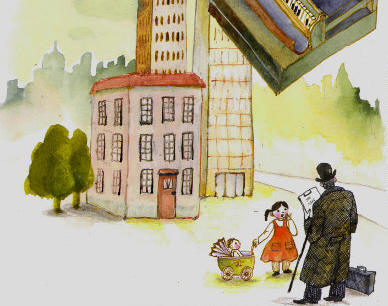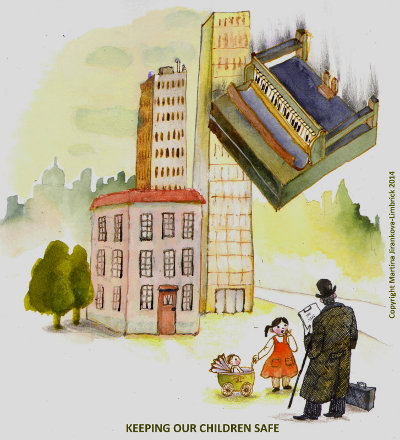 My heart, head, and all my instincts, my education in science and my past experiences as teacher and parent of young children tell me that we should not subject children to microwave radiation unless for a very good medical reason. If we come to a point where radiation is an imperative, then it should be on the fewest possible occasions and for the shortest possible duration.
My heart, head, and all my instincts, my education in science and my past experiences as teacher and parent of young children tell me that we should not subject children to microwave radiation unless for a very good medical reason. If we come to a point where radiation is an imperative, then it should be on the fewest possible occasions and for the shortest possible duration.
Here is a thought experiment: Imagine it is 1993 and you work in the Department of Education or NCB[1] (National Children's Bureau) or NSPCC or Mencap or Barnardos. I write to you to get your support for a new range of toys and learning aids that I have developed that, as a side-effect, subject children to electro-magnetic radiation while they are using them. You would have written back to me to say,
'Dear Mr Limbrick, we are going to do everything in our power to stop you in your tracks. These gadgets of yours are highly dangerous. Irradiating children in this way while they play and learn seems likely to cause all sorts of problems. If you do not take these toys off the market immediately we will use all of our powers to put you out of business.'
I chose 1993 for my thought experiment because that was the year that NCB published Children and the Environment[2] which mentioned health risks to children from radiation. As far as I am aware NCB has not published books on this subject since then.
But toys and learning aids that irradiate children are very common now and have crept up on us by stealth. The present situation, in which the common sense I postulated for my thought experiment has not prevailed, is that babies sleep next to radiating baby alarms, toddlers play with radiating toys at their nursery and children of all ages are subject, without choice, to wi-fi radiation in their classrooms.
This is not the first environmental threat to children's welfare but it is probably the biggest one yet. In my time children have been damaged by lead in paint, carbon monoxide in exhaust fumes and carcinogens in cigarette smoke (from smoking or passive smoking) – and then a host of other dangers from asbestos, insecticides, smog, etc. The repeated sequence of events in responding to these dangers is:
- General ignorance of the danger (but often, later, a suspicion that a few people knew the danger from the start but kept quiet for various reasons).
- The danger becomes very apparent to some people and campaigns start taking shape.
- Evidence of the danger mounts but is ignored and resisted by government and the industry creating the pollution.
- Evidence and concern continues to mount to the point where government has to take notice.
- Legislation and guidance follows to prevent or reduce the pollution.
While evidence is mounting now about the dangers this radiation brings to the wellbeing, health and survival of babies and children – and even of foetuses and ova – we are a very long way from stage 4 above. The fight will be a long and hard one because of the extreme wealth and power of the telecommunications industry and because of the influence it can exert over governments. Another major factor keeping us in stage 3 is that kids love the gadgets. Why wouldn't they?
A growing number of parents and teachers in England are concerned, as you can see from the list of relevant organisations and resources at the end of this letter. But where can they go to for help? When they want to protect their children from unchosen exposure to electromagnetic radiation who can they find to support them? Here is a (particularly unhelpful) list of the people and organisations they cannot go to:
The NHS
Doctors and others in the NHS will not acknowledge symptoms caused by microwave radiation. I suspect if they wanted to, they would soon fall foul of their administrators. (Some doctors in Ireland, however, show great concern[3], the Austrian Medical Association has produced guidelines[4] and the American Academy of Environmental Medicine reports, 'Multiple studies correlate RF (radio frequency) exposure with diseases such as cancer, neurological disease, reproductive disorders, immune dysfunction, and electromagnetic hypersensitivity.[5])
The Children's Commissioner
I had correspondence with the office of our first one in England and drew a blank. Please see the piano story below. I am attempting now to start a discussion with the office of the present one but I expect little success and have received no reply so far to my e-mail.
Members of Parliament
The ones I have contacted refer me to Public Health England which asserts long and hard that there are no dangers worth bothering about. One MP confided in me a few years ago that Parliament is powerless in this issue against the multinationals.
The telecommunications industry
You try it. In my last attempt over a mast erected too near our local primary school one of their representatives told me it would be thirty years before we know the effects of prolonged exposure to microwave radiation on children's health. Understandably parents tend to get angry when they feel their children are being used as guinea pigs.
There is a support vacuum here that should be filled by such major organisations as NCB, NSPCC, Children's Commissioner and others and this is the appeal of my open letter.
I put NCB, an organisation I respect greatly, at the head of my list, not because it is any better or worse than other organisations on this issue, but because, in its own words:
'The National Children's Bureau is a leading charity that for 50 years has been improving the lives of children and young people, especially the most vulnerable. We work with children and for children, to influence government policy, be a strong voice for young people and practitioners, and provide creative solutions on a range of social issues.'
Secondly, NCB showed great concern for environmental dangers in 1993 when they published Children and the Environment.
Thirdly, NCB houses the office of EDCM[6] (Every Disabled Child Matters) which links a vast number of organisations concerned about disabled children in England. I am suggesting in this letter that electromagnetic radiation is making many disabled children's problems worse and even creating disability when there was none.
The piano story: When I wrote to the first Children's Commissioner for England hoping to get his help protecting children from prolonged exposure to microwave radiation, he responded that his office could only address issues brought to it by children. I wondered, as well you might, how children are going to seek protection from this radiation before they have been alerted to the dangers.
I wrote back that, following his strategy, if one of his staff saw a piano falling down from a tall building towards a teenager on the pavement, he or she would have to get the child to complete a questionnaire instead of alerting them to the danger and suggesting they move out of the way.
I had the very same response at the beginning of this month from a major children's organisation that asserts on its website '...children and young people are growing up in a toxic climate....' They declined my invitation to add microwave radiation to their list of toxins.
While listening to children so that we can act on their concerns is an imperative, we must all at the same time do our best to educate them about the dangers around them. Otherwise, the listening stance can be a subterfuge for ignoring or remaining in comfortable denial about some hazards we should be addressing.
It is interesting to wonder which children these organisations have listened to. They certainly have not listened to foetuses and babies and probably not listened to many children with serious learning and/or communication disabilities, autism, or I suspect, children who are blind and/or deaf or ill with brain tumours and other cancers.
The following list is offered to help managers and staff in any children's organisation to decide the present stance of their organisation on dangers to babies, children and teenagers from prolonged exposure to microwave radiation in nurseries and schools. Here are the possibilities as I see them:
- You have no concerns and are content to accept assurances from the industry and government that there are no potential dangers to health and wellbeing. If you have been established for some years, this conservative stance now might indicate that you also were happy to follow the official line on dismissing concern about smoking, asbestos, carbon monoxide, etc.
- You have some real concerns and anxiety but the issue has never been brought to any staff meeting or into any strategic planning. There is no office policy to protect pregnant women and women who want to become pregnant from microwave radiation. It will probably stay like this until some pressure is brought to bear and deeper concern is raised.
- There are already real concerns and office policy dictates that pregnant women and women who want to become pregnant at some stage are protected from microwave radiation at work. This realistic concern does not yet extend to protecting children in the settings run by the organisation.
- Some staff members have been tasked to survey the international research and have become alerted to the dangers. However, the organisation fears it will lose funding from major donors and support from the government if it broaches the issue in any serious and overt actions. These real fears prevent the organisation stepping forward to protect children.
- Some staff members have been tasked to survey the international research and have become alerted to the dangers. The organisation is looking for ways to start campaigning to protect children but is nervous of doing so on its own.
Question: Where is your organisation presently positioned on this scale?
Given that it takes a long time to change government policy, there are some things you can do immediately. My personal stance is to reduce the radiation around me to a minimum. An electromagnetic radiation monitor will show you what level of microwave radiation you presently have in your nursery, school, office or home. It is a simple process to turn gadgets off one by one to see what is causing the pollution. The next stage is to see which can be wired (rather than wi-fi), which can be switched off when not in use, and which can be dispensed with. This is a common sense, precautionary approach that we all use in other aspects of our lives. Of course, this stance brings with it some inconvenience – but not as much inconvenience as one or more long-term debilitating conditions[7] and a life-threatening illness!
Finally, here are some key indicators of concern about electromagnetic radiation:
- WHO has classified microwave radiation as '2b possible carcinogen'.[8]
- International research suggests 'Children with existing neurological problems that include cognitive, learning, attention, memory, or behavioral problems should as much as possible be provided with wired (not wireless) learning, living and sleeping environments.'[9]
- The BioInitiative Report 2012 reports, 'Many disrupted physiological processes and impaired behaviors in people with ASDs closely resemble those related to biological and health effects of EMF/RFR exposure. Biomarkers and indicators of disease and their clinical symptoms have striking similarities.'[10]
- The Stewart Report[11] in April 2000 advised governments to take a precautionary approach. This has been ignored by our governments since then. There have been no tests on microwave toys, baby alarms, iPads, wi-fi laptops, DECT phones, etc. to show that they are safe for children to use or to have around them in the long term.
- The radiation is invisible and odourless. If a toddler playing with an iPad were enveloped in an orange cloud, nursery staff would be quickly alerted to the possibility of danger.
- The effects of electromagnetic radiation on the body are cumulative. The earlier and longer the exposure, the greater the danger.
- The industry asks us to wait 30 years to find out if their gadgets are damaging our children – the next generation.
This brings to an end my open letter and my appeal for help to children's organisations in England. While I have focused primarily on children, my concern is also for those people who work with children and who staff the offices of England's children's organisations.
Though I want to alert children's organisations in England to the mounting evidence about harmful effects of electromagnetic radiation, I do not offer myself as an expert on the research (far from it). Nor am I a full-time campaigner on the issue. I see my role here as making a link between children's organisations and the many sources of international information and research findings.
It is my hope that some organisations will take a serious look at the mounting evidence (being very careful to note who is sponsoring research projects) and then plan how they will start to protect babies, children and teenagers from electromagnetic radiation. Such a plan must also consider pregnant women and women who plan one day to bear children.
I believe that no organisation will get very far on its own. The most powerful approach with the best chance of eventual success would be to cluster around a well-resourced central body. I have suggested that NCB, NSPCC, the Children's Commissioner are all ideally placed for this.
Please pass this letter to others to help it reach all organisations that aim to support and protect babies (born or yet unborn), children and teenagers.
Thank you.
Peter Limbrick
February 15th, 2014
E-mail: This email address is being protected from spambots. You need JavaScript enabled to view it.

Further information
Here are some sources of further information. Please let me know if you would like someone more skilled than me to guide you as you begin your investigations:
Firstly:
What parents need to know about the safety of mobile and Wi-Fi-enabled technologies:
(http://wifiinschools.org.uk/resources/For+parents.pdf)
Electromagnetic Sensitivity and Electromagnetic Hypersensitivity – a new book by Michael Bevington:
(http://www.teamaroundthechild.com/allnews/publications/1267-new-authoritative-book-about-illnesses-caused-by-exposure-to-electromagnetic-fields-by-michael-bevington.html)
Workshop on electromagnetic fields (EMF) and health effects: From science to policy and public awareness:
(http://www.teamaroundthechild.com/allnews/events/1355-workshop-on-electromagnetic-fields-emf-and-health-effects-from-science-to-policy-and-public-awareness--greece-in-march-2014.html)
Electromagnetic radiation and health evidence, diagnosis and management. Conference by British Society for Ecological Medicine:
(http://www.bsem.org.uk/)
Reports, campaigns and relevant websites:
Bio-initiative Report - Summary:
http://www.bioinitiative.org/report/wp-content/uploads/pdfs/sec01_2012_summary_for_public.pdf
Electromagnetic Health .org:
http://electromagnetichealth.org/electromagnetic-health-blog/iarc-rf-carc/
Electrosensitivity UK:
http://www.es-uk.info/
Electromagnetic radiation monitors:
http://www.emfields.org/detectors/overview.asp
Safe Schools Information Technology Alliance:
http://ssita.org.uk/
EM-RADIATION Research Trust:
http://www.radiationresearch.org/
HESE Project:
http://www.hese-project.org/hese-uk/en/main/index.php
Mast Sanity:
http://www.mastsanity.org/
Mast-Victims.org:
http://www.mast-victims.org/
Powerwatch:
http://www.powerwatch.org.uk/
Rewire.Me e Magazine:
http://www.electrosensitivesociety.com/rewire-me-emagazine/
TETRAWATCH!:
http://www.tetrawatch.net/
The Cavi Society:
http://cavisoc.org.uk/
WiFiinschools.org.uk:
http://www.wifiinschools.org.uk/
NOTES (full links)
[1] Visit: http://www.ncb.org.uk/
[2] Visit: http://www.teamaroundthechild.com/allnews/publications/1190-children-and-the-environment-a-book-by-martin-rosenbaum-with-some-discussion-of-radiation-and-childhood-cancer.html
[3] Visit: http://ideaireland.org/library/idea-position-on-electro-magnetic-radiation/
[4] Visit: http://www.magdahavas.com/austrian-medical-association-guidelines-to-diagnosing-and-treating-patients-with-electrohypersensitivity/
[5] Visit: http://aaemonline.org/emf_rf_position.html
[6] Visit: http://www.edcm.org.uk/
[7] Visit: http://www.powerwatch.org.uk/health/micro_sickness.asp
[8] Visit: http://www.iarc.fr/en/media-centre/pr/2011/pdfs/pr208_E.pdf
[9] Visit: http://www.bioinitiative.org/conclusions/
[10] Visit: http://www.bioinitiative.org/conclusions/
[11] Visit: http://www.tetrawatch.net/papers/iegmp_icnirp.pdf


 My heart, head, and all my instincts, my education in science and my past experiences as teacher and parent of young children tell me that we should not subject children to microwave radiation unless for a very good medical reason. If we come to a point where radiation is an imperative, then it should be on the fewest possible occasions and for the shortest possible duration.
My heart, head, and all my instincts, my education in science and my past experiences as teacher and parent of young children tell me that we should not subject children to microwave radiation unless for a very good medical reason. If we come to a point where radiation is an imperative, then it should be on the fewest possible occasions and for the shortest possible duration. 
